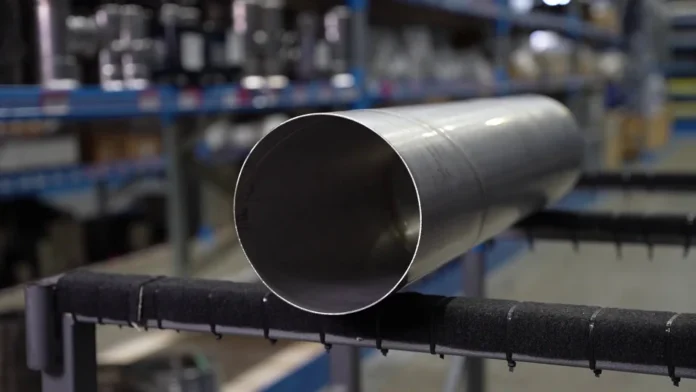In the world of industrial piping, precision, durability, and performance are vital. Among the different types of steel pipes used across industries, spiral welded stainless pipes stand out for their strength, flexibility, and efficiency in handling high-pressure applications. These pipes are commonly used in sectors such as oil and gas, water supply, construction, and infrastructure. Understanding how these pipes are made provides valuable insight into why they are preferred for large-scale projects that demand long-lasting performance and reliability.
What Is a Spiral Welded Stainless Pipe?
A Spiral Welded Stainless Pipe is a steel pipe produced by forming a continuous strip or coil of stainless steel into a spiral shape and welding the edges together along the spiral seam. This manufacturing technique allows the production of pipes with large diameters and varied thicknesses while maintaining excellent strength and corrosion resistance. For high-quality, corrosion-resistant materials and expert fabrication services, you can explore Spiral Welded Pstainless Pipe options offered by reputable suppliers known for precision engineering and long-term durability in industrial applications.
The Manufacturing Process of Spiral Welded Stainless Pipes
The manufacturing process of spiral welded stainless pipes involves several well-defined steps that ensure the pipes meet strict quality and performance standards. Each stage contributes to achieving the pipe’s structural integrity, corrosion resistance, and dimensional accuracy.
1. Selection and Preparation of Raw Material
The process begins with the selection of high-grade stainless steel coils. These coils are carefully inspected to ensure they meet chemical and mechanical specifications. The stainless steel used typically includes grades such as 304, 316, or 321, depending on the intended application. Once selected, the coil edges are trimmed and leveled to ensure consistent dimensions and a clean surface for forming and welding.
2. Spiral Forming
In the forming stage, the stainless steel coil is fed into a forming machine that gradually bends the strip into a spiral shape. Unlike longitudinally welded pipes, where the weld runs straight along the pipe’s length, spiral welded pipes feature a helical weld seam. This design allows for the production of pipes with larger diameters without requiring extremely wide sheets of steel. The spiral angle can also be adjusted to achieve the desired diameter and wall thickness.
3. Welding the Spiral Seam
Once the strip is shaped into a spiral, the edges are welded together using either a submerged arc welding (SAW) or a gas metal arc welding (GMAW) process. Submerged arc welding is the most commonly used technique due to its ability to produce high-quality, consistent welds with deep penetration. Both the inside and outside of the seam may be welded for added strength and protection. The use of stainless steel ensures that the weld joint maintains corrosion resistance similar to the base material.
4. Inspection and Non-Destructive Testing
After welding, the pipe undergoes rigorous inspection and testing to ensure it meets industry standards and quality requirements. Non-destructive testing (NDT) methods such as ultrasonic testing, radiographic testing, and hydrostatic pressure testing are used to detect any flaws, cracks, or leaks in the weld seam. Visual inspections are also conducted to verify uniformity and proper alignment of the spiral weld.
5. Sizing and Shaping
The next step involves sizing the pipe to the required dimensions. The pipe is passed through calibration rolls to achieve precise roundness and uniform wall thickness. Any distortions caused during the forming or welding process are corrected in this stage to ensure dimensional accuracy. The pipe ends are also trimmed or beveled according to customer specifications for easy joining or further processing.
6. Surface Treatment and Finishing
Surface finishing is an essential part of the process, especially for stainless steel pipes. The outer surface of the pipe is cleaned, polished, or pickled to remove oxidation, welding residue, and contaminants. This not only enhances the pipe’s appearance but also restores the natural protective oxide layer that provides stainless steel with its corrosion resistance. In some cases, passivation treatments are applied to improve resistance to environmental exposure.
7. Final Inspection and Quality Assurance
Before shipment, each pipe undergoes a final inspection to ensure it meets all mechanical, chemical, and dimensional requirements. Quality assurance teams verify that the product adheres to relevant international standards such as ASTM, API, or ISO. Proper labeling, marking, and documentation are completed to provide traceability and ensure compliance with customer and industry specifications.
Advantages of Spiral Welded Stainless Pipes
Spiral welded stainless pipes offer several advantages that make them a popular choice in industrial applications:
- High Strength and Pressure Handling: The helical weld design evenly distributes stress along the pipe’s surface, allowing it to withstand high pressure and external loads.
- Corrosion Resistance: The stainless steel material, combined with high-quality welding, ensures excellent resistance to rust, chemicals, and moisture.
- Cost Efficiency: The spiral welding process enables the use of narrower steel strips, reducing material waste and overall production costs.
- Flexibility in Size: These pipes can be produced in large diameters and long lengths, making them ideal for water transmission, oil pipelines, and structural projects.
- Ease of Installation: The pipes are lightweight relative to their strength and can be easily joined, transported, and installed.
Applications of Spiral Welded Stainless Pipes
Spiral welded stainless pipes are used across various industries due to their versatility and reliability. Common applications include:
- Water and wastewater transmission systems
- Oil and gas pipelines
- Construction and structural supports
- Marine and offshore installations
- Industrial process piping
Conclusion
The manufacturing process of the Spiral Welded Pstainless Pipe combines advanced forming, precise welding, and rigorous quality control to produce a product that excels in strength, durability, and corrosion resistance. Its unique spiral seam design and flexibility in size make it an indispensable component in modern infrastructure, energy, and industrial projects. By understanding how these pipes are made and their inherent advantages, engineers and project managers can make informed decisions that ensure performance, reliability, and long-term value in every application.

